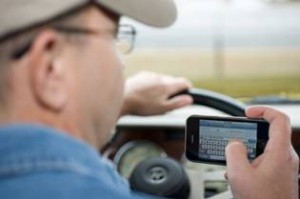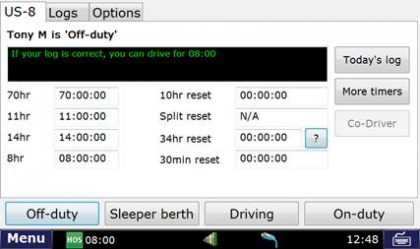Driver Distraction Issues in Commercial Trucking: Dedicated Driver Interfaces vs. Smart Phones and Tablets
Written by M. Haslam, M. Meadows, DriverTech, SLC, UT.
Statement of the Problem
“Besides penalties and possible driver disqualification, recent research shows that the odds of being involved in a safety-critical event (e.g., crash, near-crash, unintentional lane deviation) are 23.2 times greater for CMV drivers who text while driving than for those who do not. Texting drivers took their eyes off the road for an average of 4.6 seconds. At 55 mph, this equates to a driver traveling the approximate length of a football field — without looking at the roadway! For CMV drivers who dial a mobile phone while driving, the odds of being involved in a safety-critical event are six times greater than for those who do not.”
The statement above – taken from the FMCSA’s page on distracted driving – highlights the extreme risk that occurs when a commercial motor vehicle driver actively uses a smartphone while driving. This issue has gained substantial mindshare in the past years as smartphone adoption now exceeds 77% of professional drivers. Compounding this issue, many providers of software functionality have made strides to reduce costs through the introduction of fleet communication software applications for smartphones and tablets, using hardware and service plans either provided by the fleet or by the driver. Notwithstanding the business merits of this strategy, there is a serious tradeoff in safety when it comes to distracted driving since by their very nature these devices are loaded with applications and capabilities that do not differentiate whether the vehicle is Not-Parked (Driving), or Parked (not Driving).
Since 2005 trucking companies have been installing dedicated communication devices into the cabs of commercial trucks for multiple purposes including dispatch communication, automated driver logs, turn-by-turn navigation, and status reporting. These aftermarket devices provided the option to follow the SAE J2571 Recommended Practice, which includes ‘Mode Control’ (section 5). Mode Control allows the developer of both the hardware device and software applications to distinguish between Parked Mode and Not-Parked Mode, and thereby control which software application or a version of the visual interface is allowed. This determination is constantly being made automatically by the driver interface device based on the truck’s data bus output (i.e., road speed indicator).
This method has worked extremely well for over ten years in terms of minimizing Driver Distraction, and the industry has been served well. At the same time the prices of dedicated driver interface devices have come down from over $2,500 per truck to under $800 per truck, and monthly service fees have come down from over $60 to less than $40. During that ten-year period data delivered between the truck and back-office has increased by over 100 fold.
NHTSA Takes a Stand
On December 5, 2016, NHTSA published its Visual-Manual NHTSA Driver Distraction Guidelines for Portable and Aftermarket Devices proposal. The website AboutLawsuits.Com describes the guidelines as follows:
“Although NHTSA does not have the authority to implement laws deciding which programs become available to drivers on their smartphones or other electronic devices, the agency is encouraging drivers to use in-vehicle systems that are engineered and deemed safe for use while driving. A critical element of the guidelines is centered on Driver Modes, often referred to as Mode Control. Driver Modes limit the functions of a device when the vehicle’s gear is moved from Park position to the Drive position.”
NHTSA itself notes within the proposed guidelines as follows:
“NHTSA recognizes the complexity of this stakeholder ‘ecosystem’ and notes that distraction guidelines are currently not available for designing portable device user-interfaces for safe use while driving.”
In other words, there is no accepted method for smartphones and tablets to discriminate between software apps or versions of applications that can or cannot be used while the vehicle is in Driving (Not-Parked) Mode. Further NHTSA states,
“While NHTSA acknowledges that there are many available technology solutions, state laws, and consumer information campaigns designed to help reduce distracted driving, the agency believes that an important way to help mitigate the real-world risk posed by driver distractions from portable devices is for these devices to have limited functionality and simplified interfaces when they are used by drivers while driving.”
Further, NHTSA states, “Of the 967,000 distraction-affected crashes in 2014, 8 percent (69,000 crashes) involved the use of cell phones, resulting in 33,000 people injured.”
NHTSA has created a ‘lock-out’ list which includes:
Displaying video not related to driving;
Displaying certain graphical or photographic images;
Displaying automatically scrolling text;
Manual text entry for the purpose of text-based messaging, other communication, or internet browsing; and
Displaying text for reading from books, periodical publications, web page content, social media content, text-based advertising, and marketing, or text-based messages.
Exceptions to these lockouts are “two-dimensional map displays for the purpose of navigation….as long as they are displayed in a safe manner.” Additionally, NHTSA does recognize the difference between ‘portable devices’ and ‘aftermarket devices’ that take into account the specific use while driving,
“For the purposes of this Phase 2 proposal, an ‘aftermarket device’ is defined as a device designed to be or reasonably expected to be installed or integrated into a vehicle after the vehicle is manufactured, is electrically powered, and has one or more of the following capabilities:
Allows user interaction
Enters, sends, and/or receives information
Displays information in a visual and/or auditory manner, or
Displays graphical images, photographic images and/or video.”
Implications for Commercial Trucking
Because consumer smartphones do not have the means to provide Mode Control, it is the contention of the authors of this white paper that the use of consumer smartphones and tablets for commercial tasks (i.e., hours of service—ELD functions) exposes fleet operators to increased safety risk and the corresponding large damage awards. To that end, over the past 5 years, there has been a marked increase in Negligent Entrustment lawsuits. These types of lawsuits target the commercially responsible party that did not provide the recognized safe means for performing the commercial task, especially in the case where the primary reason for choosing the portable device is the reduction of cost.
An example of this can be found in an early 2012 case against Coca-Cola. A Corpus Christi, Texas, jury handed down a $21 million award against Coca-Cola after one of its drivers caused an accident while on a business call using her hands-fee cell phone. The verdict was reached despite the fact that Coca-Cola’s cell phone policy, which required the use of a hands-free device when operating a motor vehicle, was completely consistent with Texas law. The plaintiff’s attorneys in the case made the argument that Coca-Cola knew of the dangers of using a cell phone while driving and claimed that drivers have a cognitive distraction of 37 percent while on a cell phone. The plaintiff’s counsel claimed Coca-Cola withheld this information from its drivers, in addition to data on the numbers of deaths and injuries arising from cell phone use while operating the vehicles.
We speculate, based on the difficulties inherent in adding mode control, that smartphone and tablet makers will not provide any of these NHTSA requested capabilities for several years, if ever, and this will leave smartphone-based commercial applications incapable of making a ‘Driving’ vs ‘Parked’ version of their software for use on a smartphone or tablet.
In addition to application developers, it will be difficult for any stakeholder in the process to prevent drivers from misusing the smartphone or tablet in terms of self-censoring the usage of distracting applications while driving. It is paramount that fleet operators question their communications vendors as to their compliance with section 5, Operating Modes, of SAE J2571 Surface Vehicle Recommended Practice, Advanced Driver Interface Systems for Commercial Vehicle Operations.
To summarize section 5 of SAE J2571, any device that cannot itself tell the difference between the vehicle in operation and the vehicle parked cannot signal to applications upon the device that these software applications should be in a not-parked mode. Some applications by their nature do not have a safe operation mode while the vehicle is not parked, for instance, streaming video services. Devices that are not built for the purpose of being used in the cab of a sixty-ton truck, while the truck is moving down the road at 70 mph are not likely to have the capability to block the operation of apps that have been purchased from an app store–that is the nature of the problem with a smartphone or tablet used as an advanced driver interface device.
We recommend that fleets take note of both SAE J2571 and the new guidelines from NHTSA. It is our belief that if fleets don’t pay attention, personal injury attorneys certainly will, especially as NHTSA has recently put the issue in the middle of the public consciousness.
It might not be obvious what we mean in terms of what a driver sees on the screen of the mobile communication device between Driving and Parked modes. Below is an example of an application that has a ‘Parked’ version and a ‘Not-Parked’ version. In the Parked version in figure 1, you notice there are tab elements, each with quite a lot of information for the driver. In figure 2 you see no tabs, but only the key information the driver needs to see while driving, namely how many hours the driver may keep driving before a mandated sleep period.
Figure 1.
Figure 2.

There are also applications that cannot be launched when the vehicle is in Not-Parked (Driving) mode. In Figure 3 you see these as non-executable (grayed-out) application icons.
Figure 3.

Conclusion
The wide use of consumer smartphones and tablets has created an environment where users interact with these devices while driving. This interaction has led to increases in accidents estimated at roughly 10%, including an increase in traffic fatalities. For this reason, NHTSA has established proposed guidelines to reduce driver distraction and recently has targeted smartphones and tablets – singling them out as currently being incapable of providing an environment that differentiates between which software applications can be used while the vehicle is in a ‘Driving’ mode versus a ‘Parked’ mode.
NHTSA’s concern for this epidemic of accidents and fatalities is attracting the attention of personal injury attorneys who more and more can point out the potential causation of an accident as being related to the use of a portable device, by definition, a device that NHTSA has described as currently incapable of blocking distracting applications. NHTSA states:
“…it is important to note that cell phones have evolved from a portable handheld phone designed specifically for voice calls to a device that can be used for various forms of communication, entertainment, and access to content. Examples include applications developed for messaging, photo sharing, gaming, social networking, navigation, and other location-based services. While these features are not intended to be used while driving, they remain just as accessible to the driver in driving situations as any other feature on a smartphone.”
Commercial fleets should keep in mind that the adoption of smartphone and tablet-based applications, even those applications that are mandated by the federal government to meet the requirements of the ELD mandate, opens up the fleet to distracted driving situations, a higher likelihood of serious accidents and the possible charge of negligent supervision. This risk of liability will exist at least until the smartphone and tablet industry has provided a means to follow the NHTSA guidelines for Parked Mode versus Driving Mode for portable devices.
In the meantime, the safe alternative is to use time-tested aftermarket systems that meet the requirements of SAE J2571 Mode Control and are capable of locking out certain applications while the vehicle is being driven, or can make only the drive-safe version of the application available to the driver.

